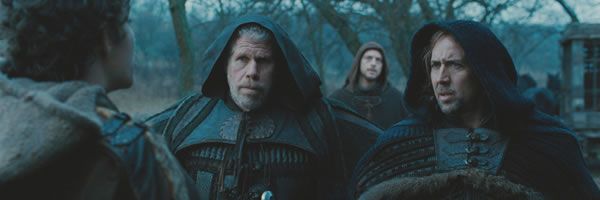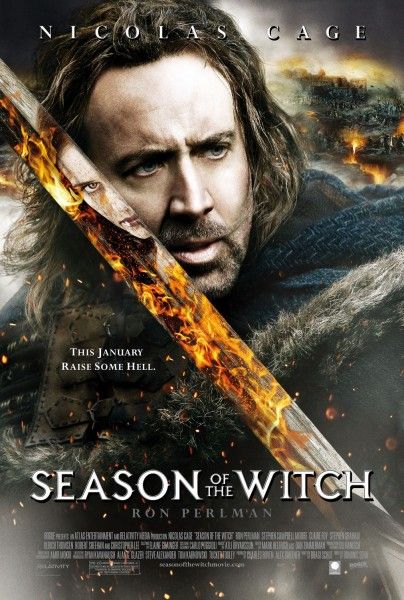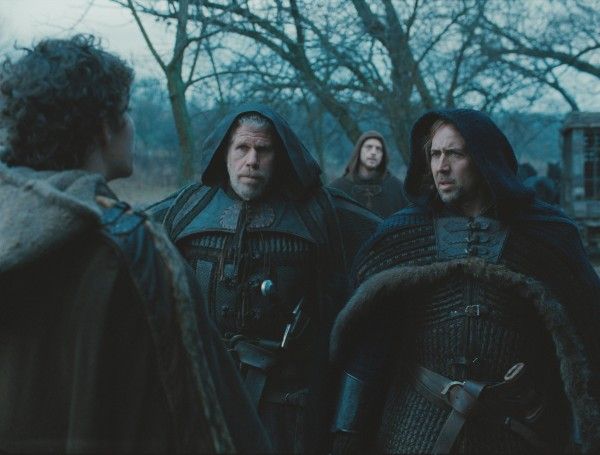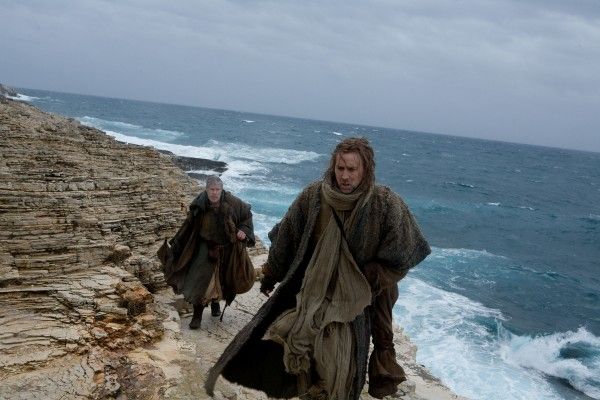Season of the Witch is a supernatural action adventure that follows Behman (Nicolas Cage), a man who returns home after years of brutal warfare, only to find his world destroyed by the Black Plague. When the church elders, convinced that a girl accused of being a witch (Claire Foy) is responsible for the devastation, command Behman and his closest friend Felson (Ron Perlman) to transport the strange girl to a remote monastery where monks will perform an ancient ritual to rid the land of her curse, the men embark on a harrowing, action-filled journey that will test their strength and courage. As the mission is made even more challenging by increasingly disturbing events, the men discover the girl’s dark secret and find themselves battling a powerful force that will determine the fate of the world.
In a recent exclusive phone interview with Collider, Academy Award winner Nicolas Cage talked about why he was attracted to this project, getting to use a sword and ride a horse for the role, working with Christopher Lee, who he is a true admirer of, re-teaming with director Dominic Sena (they did Gone in Sixty Seconds together), and how much he enjoyed filming in Austria. Check out what he had to say after the jump:
Also, if you missed what Cage told us about Ghost Rider: Spirit of Vengeance and Kick-Ass, you can click here for those comments. We previously posted that part of the interview. Finally, you can watch nine movie clips from Season of the Witch here.
Question: How did you get involved with this project and what was the appeal of this character for you?
NICOLAS CAGE: I think that I was in the right place at the right time in my head, for this kind of role. I wanted to make a movie that was really scary, play a knight and hang out in the forest, for a few years now, and that’s exactly what this movie provided me with. It was also another chance to work with Chuck Roven. We made City of Angels together, and I wanted to go back into the supernatural with him again. We did that on City of Angels, and now again with Season of the Witch. I find that these invisible forces are really fascinating and interesting for me to work with, in terms of the characters I play. It gives me a little bit more range to get abstract. That all appealed to me. Plus, the idea of playing a knight was something that I had been doing, ever since I was a child, in my backyard, so this gave me a chance to do it, as a child’s dream come true.
It definitely seems like one of those imagination come to life roles.
CAGE: Yeah, that’s exactly what it was. So, I didn’t hesitate. I wanted to be a part of it, immediately.
What was it about the way they described this character to you that really hooked you in?
CAGE: I admired in the character and responded to the idea of him being the first conscientious objector, and the idea of him breaking from whatever religious propaganda was forced upon him, and still finding an even closer connection with his faith and with God. Those iconoclastic elements to the character made him very interesting to me.
Once you had signed on to do this project, were there any specific changes that you wanted to make to the character?
CAGE: Not so much. I knew that I had to become pretty adept with the sword and also comfortable on a horse, neither of which I had ever done before, so I immediately finished on Bad Lieutenant and went right into photography and rehearsal on Season of the Witch. I had really no time in between, so I was just trying to get all the sword work dialed in and have it go into my body in such a way where I didn’t have to think about it. And then, I was just religiously riding horses every day, until I felt confident that I could perform with the horse on camera.
You do a lot of physical work in many of your films. Is that something that you enjoy doing? Does it always present a challenge for you, or does it get easier since you do it fairly frequently?
CAGE: I do like to move and get physical in my movies. I’m much more comfortable in outdoor, open spaces, in this case, in the forest. It’s been 30 years now and I don’t have the same body I had when I was 17, but I’m still doing very physical work, so let’s just say I’m more aware of it now.
What are the most challenging aspects of bringing a period piece like this to life, and what are the most fun aspects of telling a story of another time?
CAGE: I think the challenge was really trying to be authentic and commit to the idea of myself as a knight, and the two ways into that were the horseback riding and the sword fighting. Those were the elements that had to be authentic, otherwise I don’t think it would have worked. But, the fun of it really is just this opportunity to bring to life this child’s dream that I have, and also the awe and mystery of invisible forces at work, that may or may not exist. It gives me something to work on that I am personally interested in and so, therefore, it’s honest, it’s a sincere offering that I’m giving to you and I would go see that movie myself, even if I had nothing to do with it.
Was this a very green screen heavy film, or did you also have some practical stuff there as well?
CAGE: It was mostly all natural. We’re really out there, we’re really on the horses, we’re really in the forest. There was very little green screen used. I think we only did maybe four days of green screen. After we had done principal photography, a few months later, we did another series of battle sequences, and in order to save travel and other elements, there was some green screen involved in that as well.
What does it mean to you, as an actor, to work with someone like Christopher Lee?
CAGE: I’m an enormous admirer of Christopher Lee. He’s somebody, along with Vincent Price, who I celebrate, and I wanted my movies to show that celebration and that honoring of these great film stars that were unafraid to go into horror and Grand Guignol and the macabre. So, I’m trying to build a body of work that shows that. I can only say that he’s a wonderful icon and he continues to do remarkable work. Look at what he did in The Lord of the Rings. So, I’m very happy to have had that experience.
Do you have any favorite Christopher Lee films?
CAGE: I really loved his performance in The Wicker Man. That really stood out for me, and I told him that when I saw him. I told him what a fan I was of, really, all of his work, but in that one really, to me, he went to a new level.
How was Ron Perlman to work with?
CAGE: Ron is somebody that I didn’t have to act with. I genuinely like Ron. He’s got a great sense of humor. He’s a good man. I like spending time with him, and enjoyed many of our conversations. It was really quite easy.
What is Dominic Sena like, as a director and a collaborator?
CAGE: Dominic is somebody that is great for actors because he really liberates you and lets you feel comfortable and relaxed and free to come up with ideas. He won’t just shoot it down. He’ll embrace it and let you go for it. I had that experience with him on Gone in Sixty Seconds, and now again with Season of the Witch. But, I would say that, whereas Gone in Sixty Seconds was more of an urban, straight-up action film, this one really gave Dom a chance to go into the abstract. He’s so imaginative visually that he’s able to do things with landscapes and with what’s in the frame that it’s unique, it’s creative and it’s Dom Sena. That’s something I wanted to be able to do with him, and I was very happy to be reunited with him.
Having filmed this in Austria, Hungary and Croatia, if you could go back to any of those countries, which would you go to first? And for people who have never been there, what would you recommend about those countries?
CAGE: I would definitely return to Austria. They were all good experiences for me, but definitely Austria because there were some ancient Celtic, sacred sites that were in the forest that were quite beautiful. There’s just an energy there that is undeniable. It is like being in a Grimm’s fairy tale, in a magic forest. If you’re interested in that sort of thing, I recommend going to Austria and staying at the Seehof Hotel. Just take a few days, let your mind wander and just experience that. But, I do think it’s important to state that the movie is shot on location and it’s not green screen, so for those of us who like a little bit of travelog in their movies will definitely get that with this film.




